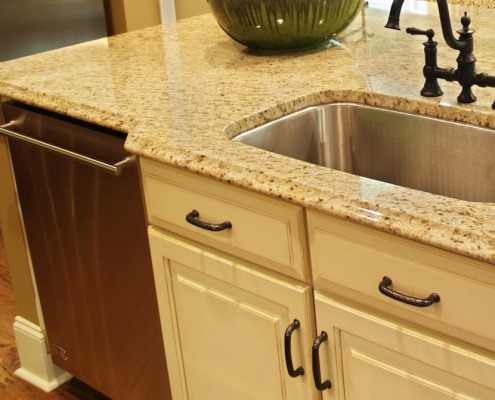Trash Compactor Drawer Is Hard To Open Or Close: Top 3 Reasons and Fixes (With Video!)
APP Expert / Monday June 6, 2022
Is your trash compactor drawer becoming a stubborn obstacle in your kitchen routine? Don’t let sticky garbage gunk ruin your day! Dive into our guide and discover the secrets to a smoother trash compactor experience—complete with a helpful how-to video right below to walk you through every step.
Need a replacement part for your garbage compactor? Search below using your specific trash compactor model number to identify the exact part needed:
Any door or drawer that runs on rails is likely to encounter some problems opening and closing eventually. For trash compactors, which deal with gunky garbage on the regular, this issue can arise fairly frequently. Whether it’s just a minor annoyance or it’s stopping you from running your compactor entirely, it’s not something you need to live with – it’s something you can fix yourself!
Keep reading to find out the three most common causes of issues with trash compactor drawers and a few tips on how to fix them. You can watch our video tutorial, too, for an in-depth look at each possible issue!
How To Open A Stuck Trash Compactor Drawer
Your trash compactor’s door will need to be open to diagnose most issues. If it’s stuck shut, that presents a problem all its own – how do you get it open? Depends on the issue:
- The compactor’s ram – the component that pushes all the trash down – should be in the top position. If it’s not completely raised, your compactor’s drawer will not open. The appliance may need to be reset or restarted to kickstart the ram. Try pushing the drawer closed as you press “ON” or turn the compactor’s knob to “START.”
- Make sure the right mode is engaged. Some models of trash compactor have modes that force the ram to stay in the lowest possible position and lock your compactor. Make sure that’s turned off.
- The latch could be stuck. Use a putty knife to spring the latch, but make sure your appliance is completely disconnected from any power sources before doing this!
- The drawer needs to be free of any obstructions. To fix this issue, the trash compactor will need to be removed from your cabinet space and partially disassembled. If your compactor was full, this could get messy, so lay down a tarp, towel, or newspapers before turning the appliance on its side to reach the bottom.
These won’t necessarily fix your problem, but if you can at least get your compactor to a state where the drawer will open, you can start to solve your problem. Next, let’s take a look at what that issue might be…
3 Reasons Your Trash Compactor Won’t Open Or Close
So you’ve got your trash compactor’s drawer open, but sliding it in and out is still tougher than it should be. The culprit here is usually either a whole lot of gunk that needs to be cleaned up or a plastic or thin metal component that has broken or bent out of shape. Luckily, these are pretty quick and easy problems to spot and fix.
Tools for the job
The good news is, for a simple check, you don’t need any specific tools. If you’re doing more than just troubleshooting, there are a few things that can help:
- Water with a bit of detergent or a grease buster can help clean up gunk that might be causing your compactor’s components trouble. Remember to have a rag or paper towels on hand to help with cleaning.
- A mallet can be used to tap bent metal parts back into shape if you run into any. Don’t overdo it, though, or you may wind up needing to replace a part!
- A small flathead screwdriver or putty knife can be used to release stuck locking tabs or get debris out from places where it might be gumming up the works.
Before you begin…
For safety, make sure you disconnect your trash compactor from power either at the wall outlet or circuit breaker. By making sure your appliances are not receiving power before starting maintenance, you’re protecting yourself from a potentially nasty or even life-threatening shock.
1. The Drawer Rollers
The trash compactor drawer slides in and out on two sets of rollers – one set mounted to the frame of the compactor, and one set on the drawer itself. While they look different, the rollers are generally composed of the same parts: a roller with a ball-bearing center, a mounting shaft, and a spacer. These free-spinning wheels facilitate the drawer’s movement on rails, so naturally, if they are damaged, it can seriously gum up the works.
You don’t need any tools to test your compactor’s rollers. To start, open the drawer up and have a look at both rollers. A visual and physical inspection of the parts should be enough to tell you what the issue is:
- Gunky buildup can seriously impact how well your rollers work, so check for grime or other obstructions. If any of the rollers are particularly dirty, you can clean them with soap and water. Just be sure to also dry them off thoroughly, too.
- Are there any cracks or flats in the rollers? Most compactor rollers are plastic, and it’s possible that, with extended use, they can start to flatten out, crack, or chip. This sort of damage can make moving the drawer in and out a lot more difficult and will only get worse with time, so if you notice it, it’s time to replace the rollers.
- Give the wheels a spin. They should move freely, without much resistance. If they grind a bit and don’t want to move, the bearings in the center may have gone bad, and the rollers will need to be replaced.
- Make sure the roller assembly is mounted firmly. If the whole roller assembly is wobbly or loose, it may need to be tightened down. Check that the mounting shaft isn’t stripped. If it is, it’s time to swap those old rollers out for new ones.
2. The Foot Pedal
Many trash compactors can be unlocked and opened by foot pedal – a lever, usually made of plastic, installed at the bottom of the drawer. This component generally consists of little more than the pedal itself and two plastic mounting points at each end. Stepping down too hard on the pedal or shutting the drawer too forcefully could potentially damage the pedal’s mounting points, which in turn will make opening, shutting, and latching the drawer difficult or even impossible.
This component is another that can be tested without any special tools. A visual and physical inspection should again be enough to test this part:
- The foot pedal should be up when the drawer is closed, and should release when stepped on. If it’s always in a released state, then one of the mounting tabs may have broken, and the pedal will need to be replaced.
- If the pedal itself is cracked, this will likely prevent it from working as intended. A cracked pedal will need to be replaced.
- Make sure there’s nothing gunking the works up. Open the drawer and check the pedal at the seam and, if you can reach them, the connection points. Make sure they’re free of any grime.
3. The Drawer Tracks
The drawer rollers ride in a set of metal tracks on the inside of the trash compactor. These components do not often fail, but when they do it can cause a number of issues with opening and closing the appliance. If you find that the drawer gets stuck halfway open or halfway closed, or if you have to push or pull sharply to completely open or close the drawer,it could be because the rollers are getting stuck on the rails.
Open your trash compactor drawer up all the way to examine the rails.
- Make sure they’re clear of any gunk or debris that might catch the rollers, and clean them off if you spot any.
- Check both rails for dents or bends. You may be able to hammer these out by tapping them with a mallet, but if that isn’t working, the rails may need to be replaced.
- Check both rails to make sure that they are firmly mounted to the sides of the disposal. If they’re loose or wobbly, this is likely causing your drawer problem. Go ahead and tighten them down.
Finding The Right Replacement Part
You may not need to replace any parts to fix a problem with your trash compactor’s drawer, but if you do, we can help! It all starts with finding the right replacement component.
Locate your trash compactor’s model number, which you can find on a label somewhere on the appliance. It’s most likely inside the unit somewhere, so start by opening the drawer and checking around the door and inside of the cabinet. If you can’t find a sticker, you can consult your compactor’s manual for at least a partial model number.
Got the model number? Great! Type it in to the search at AppliancePartsPros.com to find a list of compatible parts. You can also browse our trash compactor parts page and narrow the search down by your compactor’s brand, if you weren’t able to find your full model number. Order through us and you should have a genuine OEM replacement part in just a couple of days!
Wrapping Up
Often issues with the trash compactor can be solved quickly with a bit of soapy water, but even bigger problems can be quick fixes with the right replacement parts. Now that you and your trash compactor are back on rails, why not check out what else AppliancePartsPros.com can help you with? If you need tips, tutorials, or genuine replacement parts, our friendly staff is happy to help!
If you need any replacement parts for your appliances, you can enter your model number at AppliancePartsPros.com to locate and order them quickly. Most orders arrive in just two business days, and we have tons of great information in our repair help section and YouTube videos to help you troubleshoot.
Stay connected with the latest DIY tips, tutorial videos, and repair guides by following us on Facebook, Instagram, and Twitter. We love hearing about your repair stories and successes. If you need more help or want personalized guidance, feel free to contact or call us at 877-477-7278. We’re ready to help you take on your next project with confidence!
Since 1999, AppliancePartsPros.com has helped millions of people repair their broken appliances by providing high-quality original parts at well below retail prices, free support and troubleshooting, and award-winning customer service from an expert, friendly, US-based customer support team!
Hi! I’m Matt H., and I’m thrilled to be your guide through the world of appliance repair with over 25 years of invaluable experience in the industry.
From the early days of my career, I have been deeply passionate about appliances and their inner workings. Over the years, I’ve seen it all – from vintage models to the latest cutting-edge technology – and I’ve dedicated myself to mastering the art of repair. With a toolbox in one hand and a wealth of knowledge in the other, I’ve tackled every challenge that has come my way, learning and growing with each repair.
Join me as we dive into the intricacies of appliance repair. From step-by-step repair guides to explanations of common problems and their solutions, I’ll be here to simplify the repair process and empower you with the knowledge you need to keep your appliances running smoothly.
Feel free to explore our blog, ask questions, and leave comments – this platform is a space for learning, sharing, and growing together. Let’s work together to ensure that your appliances continue to serve you for years to come.
Thank you for joining me on this journey, and I look forward to being your go-to resource for all things related to appliance repair!





